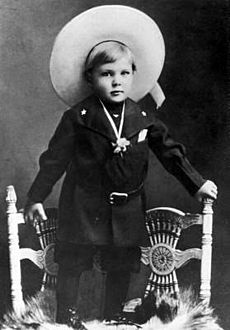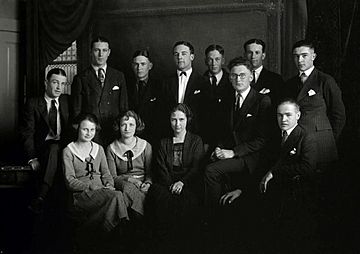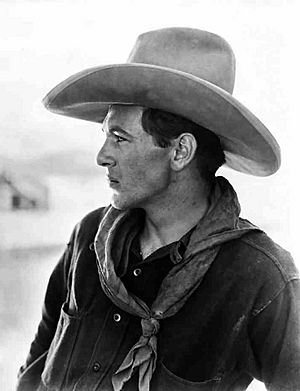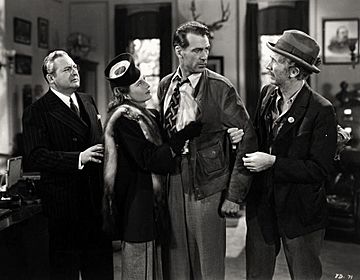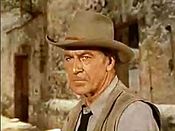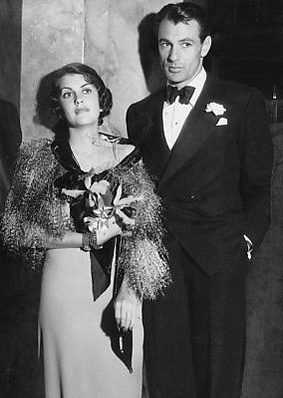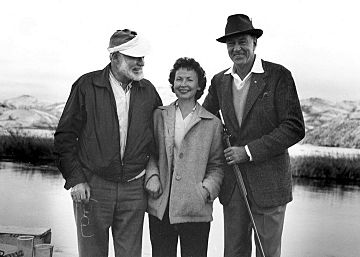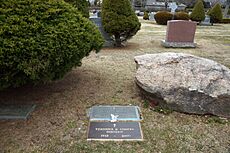Gary Cooper facts for kids
Quick facts for kids
Gary Cooper
|
|
|---|---|
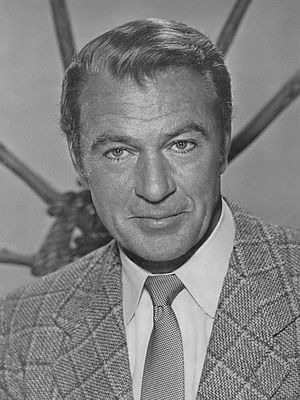
Cooper in 1952
|
|
| Born |
Frank James Cooper
May 7, 1901 Helena, Montana, U.S.
|
| Died | May 13, 1961 (aged 60) Los Angeles, California, U.S.
|
| Resting place | Sacred Hearts Cemetery, New York, U.S. |
| Other names | Coop |
| Education | Grinnell College |
| Occupation | Actor |
| Years active | 1925–1961 |
| Political party | Republican |
| Spouse(s) |
Veronica Balfe
(m. 1933) |
| Children | 1 |
| Signature | |
 |
|
Gary Cooper (born Frank James Cooper; May 7, 1901 – May 13, 1961) was a famous American actor. He was known for playing strong, quiet characters in his movies. He won two Oscars for Best Actor and received an honorary Oscar for his amazing career in 1961.
Cooper's acting career lasted 36 years, from 1925 to 1961. He starred in 84 feature films. He was a big movie star from the end of the silent film era through the "Golden Age" of Hollywood movies. His characters often showed what people thought of as the ideal American hero.
He started as a film extra and stunt rider. Soon, he got bigger acting roles. He became a movie star in 1929 with his first sound film, The Virginian. In the 1930s, he played heroes in adventure films and dramas like A Farewell to Arms (1932). Later, he played everyday heroes in movies such as Mr. Deeds Goes to Town (1936) and Sergeant York (1941). In his last films, he played characters looking for a fresh start, like in Friendly Persuasion (1956).
Contents
Growing Up in Montana
Frank James Cooper was born in Helena, Montana, on May 7, 1901. His parents, Alice and Charles Henry Cooper, were from England. His father was a lawyer and a judge in Montana.
In 1906, his father bought a large cattle ranch near Craig, Montana. Gary and his older brother, Arthur, spent their summers there. They learned to ride horses, hunt, and fish.
His mother wanted her sons to have an English education. So, in 1909, she took them to England. Gary studied Latin, French, and English history at Dunstable Grammar School. He found the strict school rules and formal clothes difficult. In 1912, he returned to the U.S. and continued school in Helena.
When Gary was 15, he hurt his hip in a car accident. To get better, he went back to the ranch and rode horses. This made his walk a bit stiff, which became a unique part of his acting style. He left high school in 1918 to work full-time as a cowboy.
In 1919, his father arranged for him to attend another high school in Bozeman, Montana. An English teacher there encouraged him to focus on school and join debating and drama.
Gary was interested in art from a young age. He admired Western painters like Charles Marion Russell. In 1920, he took art classes at Montana Agricultural College.
In 1922, Cooper went to Grinnell College in Iowa to continue his art studies. He did well in most classes but wasn't accepted into the drama club. His drawings were shown around the dorm, and he became the art editor for the college yearbook.
During the summers of 1922 and 1923, he worked as a tour guide at Yellowstone National Park. He drove the yellow open-top buses. In 1924, he left college and tried to find work as an artist in Chicago. He then returned to Helena and sold cartoons to a local newspaper.
In late 1924, Cooper moved to Los Angeles to join his parents. After trying a few jobs, he met friends who were working as film extras and stunt riders in Western movies. He started working as an extra for $5 a day and a stunt rider for $10. He wanted money for a professional art course.
Starting His Acting Career
Silent Films: 1925–1928
In 1925, Cooper began his film career in silent movies. He appeared in Westerns like The Thundering Herd and Riders of the Purple Sage. He was good at riding horses, which helped him get steady work in Westerns. However, he found stunt work "tough and cruel" because it sometimes hurt horses and riders.
Hoping to become an actor, Cooper paid for a screen test. He hired Nan Collins as his agent. She suggested he change his first name to "Gary" after her hometown of Gary, Indiana. He liked the name right away.
He also worked in non-Western films, like The Eagle and Ben-Hur. Slowly, he started getting roles where he was credited and had more screen time. On June 1, 1926, Cooper signed a contract with Samuel Goldwyn Productions for $50 a week.
Cooper's first important role was in The Winning of Barbara Worth (1926). He played a young engineer. Critics noticed Cooper and called him a "dynamic new personality." Goldwyn offered him a longer contract, but Cooper got a better deal with Paramount Pictures for $175 a week.
In 1927, with help from actress Clara Bow, Cooper got important roles in Children of Divorce and Wings. Wings was the first movie to win an Oscar for Best Picture. That year, Cooper also starred in his first main roles in Arizona Bound and Nevada.
Paramount paired Cooper with Fay Wray in films like The Legion of the Condemned (1928). Cooper's acting skills improved, and he became very popular, especially with female fans. He was earning $2,750 per film and getting 1,000 fan letters a week. He also made Lilac Time (1928), his first movie with synchronized music and sound effects. It was a big hit.
Becoming a Hollywood Star: 1929–1935
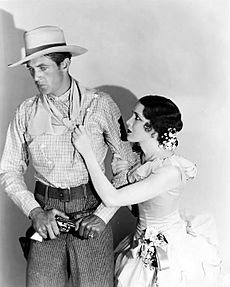
Cooper became a major movie star in 1929 with his first talking picture, The Virginian. This film helped define the Western hero. Unlike some silent film actors, Cooper easily moved to sound films. His "deep and clear" voice was perfect for his characters.
Paramount quickly cast him in more Westerns and war dramas, like Only the Brave and The Texan (both 1930). Artist Norman Rockwell even put Cooper on the cover of The Saturday Evening Post as The Texan.
One of Cooper's important early roles was in Morocco (1930) with Marlene Dietrich. The director, Josef von Sternberg, was tough on Cooper. Cooper once picked him up by his collar and told him to speak English. Despite the problems, Cooper gave a great performance.
After a Western, Fighting Caravans (1931), Cooper starred in the crime film City Streets (1931). He played a Westerner who gets involved with gangsters to save the woman he loves. Making 10 films in two years left Cooper tired and sick. He felt lonely and depressed by his sudden fame. In May 1931, he left Hollywood and traveled to Algeria and Italy for a year.
While abroad, Cooper learned about fine food and wines. He went on a 10-week hunting safari in East Africa, where he hunted lions and other animals. This experience made him love the wilderness even more. He returned to Hollywood in April 1932, healthy and refreshed. He signed a new contract with Paramount for $4,000 a week.
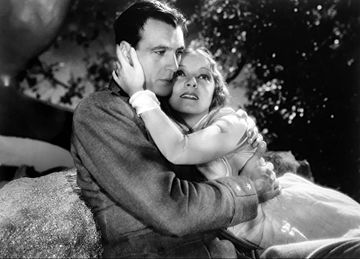
In 1932, Cooper starred in A Farewell to Arms, based on a novel by Ernest Hemingway. He played an American ambulance driver wounded in World War I who falls in love with a nurse. Critics praised his emotional performance, and the film was a big success.
In 1933, Cooper appeared in the comedy Design for Living. He played an American artist in Europe. This film showed his talent for light comedy. In August 1933, he legally changed his name to "Gary Cooper."
In 1934, Cooper made Now and Forever with Carole Lombard and Shirley Temple. He played a con man who tries to sell his daughter. He became close friends with the young Shirley Temple. The film was a box-office hit.
In 1935, Cooper starred in The Lives of a Bengal Lancer. He played a British officer defending a fort in India. This adventure film was nominated for seven Academy Awards and was very popular. The director, Henry Hathaway, called Cooper "the best actor of all of them."
Becoming an American Folk Hero: 1936–1943
From Mr. Deeds to The Real Glory, 1936–1939
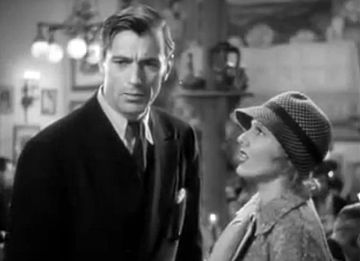
Cooper's career changed in 1936. He made Mr. Deeds Goes to Town with Jean Arthur. He played Longfellow Deeds, a quiet greeting card writer who inherits a fortune. He goes to New York City and faces a world of corruption. The director, Frank Capra, used Cooper's image as an honest and good American hero to create a new type of "folk hero" for ordinary people.
Both Desire and Mr. Deeds were big successes in April 1936. Critics praised Cooper's acting. He received his first Oscar nomination for Best Actor for Mr. Deeds.
In 1936, Cooper also played Wild Bill Hickok in the Western epic The Plainsman. This film was a huge hit. From 1936 onwards, Cooper was listed among the top-10 film personalities for 23 years.
In 1937, Cooper appeared in Souls at Sea, which was not very successful. In 1938, he starred in The Adventures of Marco Polo, which also struggled. During this time, Cooper turned down the role of Rhett Butler in Gone with the Wind. He felt he wasn't right for the part, and later agreed Clark Gable played it perfectly.
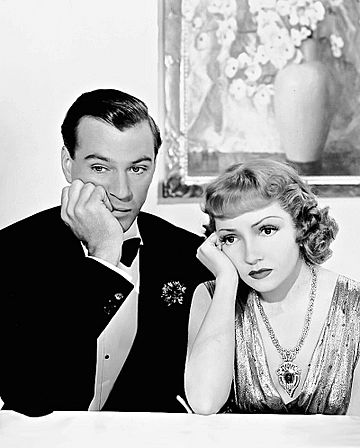
He returned to romantic comedy in Bluebeard's Eighth Wife (1938) with Claudette Colbert. He played a rich American businessman who falls in love with an aristocrat's daughter.
In 1939, Cooper made Beau Geste, an adventure film about three English brothers who join the French Foreign Legion. This film was a great fit for Cooper's personality. It was his last film under his contract with Paramount.
He also starred in The Real Glory (1939), playing a military doctor in the Philippines. Many critics praised his performance.
From The Westerner to For Whom the Bell Tolls, 1940–1943
Cooper returned to Westerns in The Westerner (1940). He played a cowboy who defends settlers against a corrupt judge. The film was well-received and did well at the box office. That same year, he appeared in his first film in full color, North West Mounted Police (1940). He played a Texas Ranger. This film was also a box-office success.
The early 1940s were some of Cooper's best years as an actor. He starred in several popular and critically acclaimed films. In Meet John Doe (1941), he played a man who becomes a symbol of hope. The film was a big event, and Cooper appeared on the cover of Time magazine. Critics praised his "splendid and utterly persuasive" acting.
That same year, Cooper made Sergeant York. He played Alvin C. York, a real-life war hero from World War I. Cooper was nervous about playing a living hero, so he visited York at his home. They became friends. Cooper's performance was highly praised and earned him his first Oscar for Best Actor. Sergeant York was the highest-grossing film of the year.
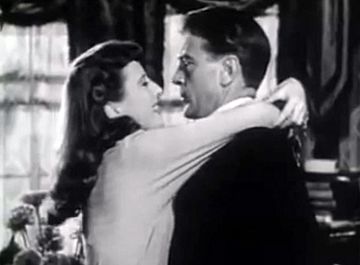
Cooper ended 1941 with the romantic comedy Ball of Fire with Barbara Stanwyck. He played a shy professor. Critics loved his "delightful" performance. It was one of the top-grossing films of the year.
In 1942, Cooper's only film was The Pride of the Yankees. He played baseball star Lou Gehrig. Cooper knew little about baseball and wasn't left-handed like Gehrig. But after Gehrig's widow asked him to play her husband, Cooper accepted. He quickly learned how to play baseball for the role. The film was a top-10 picture and received 11 Oscar nominations, including one for Cooper.
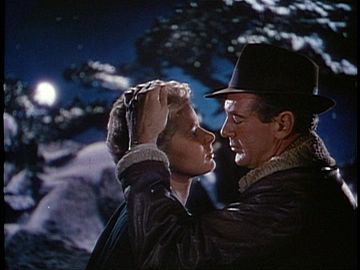
In 1943, Cooper starred in For Whom the Bell Tolls, based on Ernest Hemingway's novel. He played Robert Jordan, an American fighting in the Spanish Civil War. Ingrid Bergman played the female lead. Their love scenes were very passionate. The film was a big success and received 10 Oscar nominations, including one for Cooper.
World War II Activities
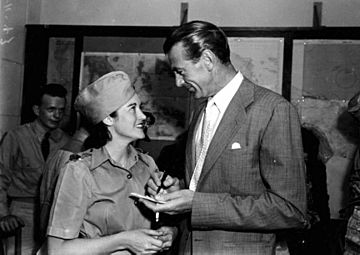
Because of his age and health, Cooper did not serve in the military during World War II. However, he helped the war effort by entertaining troops. In 1943, he visited military hospitals and the Hollywood Canteen, where he served food to servicemen.
Later in 1943, Cooper went on a long tour of the South West Pacific. He visited places like the Cook Islands, Fiji, and New Guinea. He met with soldiers and nurses, visited hospitals, and performed skits. He often ended his shows by reciting Lou Gehrig's famous farewell speech. Cooper later called his time with the troops the "greatest emotional experience" of his life.
Later Roles: 1944–1952

In 1944, Cooper appeared in The Story of Dr. Wassell, a wartime adventure film. Despite poor reviews, it was one of the top-grossing films of the year. Cooper then became an independent actor and formed his own production company. His first film with his new company was Casanova Brown (1944), which did not do well.
In 1945, Cooper starred in and produced the Western comedy Along Came Jones. This film was a big box-office success.
After the war, Cooper's career changed. He still played heroes, but his films focused more on new stories and exotic places. In 1945, Saratoga Trunk was released. It was filmed earlier but delayed due to the war. Despite bad reviews, it was a top moneymaker.
In 1946, Cooper made Cloak and Dagger, a romantic thriller. He played a physics professor investigating the German atomic-bomb program. Cooper felt uncomfortable in the role, and the film was not successful. In 1947, he appeared in Unconquered, an epic adventure film. This was his most profitable film with director Cecil B. DeMille.
In 1948, Cooper sold his company and signed a new contract with Warner Bros. His first film under this contract was The Fountainhead (1949). He played an idealistic architect. Many critics felt Cooper was not right for this role.
Cooper returned to a more familiar role in Task Force (1949). He played a naval aviator. This film was very popular. In the next two years, Cooper made four films that were not well-received.
Cooper's most important film during this time was the Western drama High Noon (1952). He played Sheriff Will Kane, who must face outlaws alone. During filming, Cooper was in pain from stomach ulcers. His tired look added to his character's struggle. High Noon was praised for its artistry. Critics said Cooper was "at the top of his form." The film was a huge success and earned Cooper his second Oscar for Best Actor.
Later Films: 1953–1959
After Springfield Rifle (1952), Cooper made four films outside the United States. In Return to Paradise (1953), he played an American wanderer on a Polynesian island. He faced tough living conditions and health issues during filming in Samoa. The film received poor reviews.
His next three films were shot in Mexico. These included Blowing Wild (1953) with Barbara Stanwyck, and the Westerns Garden of Evil (1954) and Vera Cruz (1954) with Burt Lancaster. These films received poor reviews but did well financially. For Vera Cruz, Cooper earned $1.4 million.
Cooper continued to have health problems. He injured his shoulder and hip during filming. He also had ongoing treatment for ulcers.

In 1955, Cooper appeared in The Court-Martial of Billy Mitchell, a war drama. Some critics felt he was not right for the role. In 1956, Cooper was more effective playing a kind Quaker in Friendly Persuasion. This film was nominated for six Academy Awards and won an award at the 1957 Cannes Film Festival. It earned $8 million worldwide.
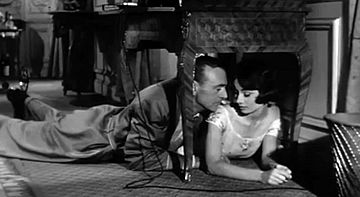
Cooper traveled to France in 1956 to make the romantic comedy Love in the Afternoon with Audrey Hepburn. Most reviewers felt Cooper was too old for the part. The next year, he appeared in Ten North Frederick, a romantic drama.
Despite his health issues, Cooper continued to work in action films. In 1958, he starred in the Western drama Man of the West. He played a reformed outlaw forced to face his violent past. This film is now considered one of Cooper's last great movies.
After his contract with Warner Bros. ended, Cooper formed his own production company. In 1959, he made three films about finding a new path. In The Hanging Tree, he played a frontier doctor. In They Came to Cordura, he played an army officer. In The Wreck of the Mary Deare, he played a merchant marine officer trying to clear his name. Cooper, a trained scuba diver, did most of his own underwater scenes in this film.
Personal Life
Marriage and Family
Gary Cooper met his future wife, 20-year-old Veronica Balfe, in 1933. Her friends and family called her "Rocky." They married on December 15, 1933. Friends said the marriage had a good effect on Cooper. Rocky loved the outdoors, just like Cooper. They shared interests like riding, skiing, and skeet-shooting. Her social connections also helped Cooper.
Gary and Veronica Cooper's daughter, Maria Veronica Cooper, was born on September 15, 1937. Cooper was a loving father. He taught Maria to ride bikes, play tennis, ski, and ride horses. She often traveled with them and shared their love for art. The family vacationed in Sun Valley, Idaho and Europe.
Cooper and Rocky separated in May 1951 but got back together in February 1954.
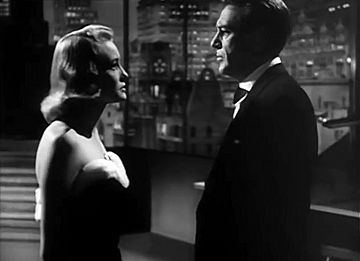
Friendships and Interests
Cooper loved the outdoors. He once said that the most satisfying things in life, like hunting, watching sunsets, or seeing a bird in the wind, are free.
Cooper had a 20-year friendship with writer Ernest Hemingway. It began in Sun Valley in 1940. Hemingway even used Cooper's image when creating a character for his novel For Whom the Bell Tolls. Both men loved the outdoors and often hunted and skied together. Hemingway believed Cooper's real personality matched his heroic screen characters.
Cooper's social life often involved sports, outdoor activities, and dinner parties with friends from the film industry. These included directors Henry Hathaway and Howard Hawks, and actors James Stewart and Barbara Stanwyck. Besides hunting, he enjoyed riding, fishing, skiing, and later, scuba diving.
He never stopped loving art and drawing. He and his wife collected modern paintings by artists like Pierre-Auguste Renoir and Pablo Picasso. Cooper also loved cars and owned a collection, including a 1930 Duesenberg.
Cooper was a quiet and thoughtful person. He loved being alone in nature. Like his movie characters, he often used long silences, saying "yup" or "shucks" instead of many words. He once said, "If others have more interesting things to say than I have, I keep quiet." Friends said he was charming, polite, and had a good sense of humor. He was modest and never misused his movie-star status.
Political Views
Cooper was a Republican and a conservative. He supported Republican candidates in presidential elections. He campaigned for Wendell Willkie in 1940 and Thomas E. Dewey in 1944. He believed in the "American way of life" and criticized ideas he felt were "un-American."
He was a founding member of the Motion Picture Alliance for the Preservation of American Ideals. This group opposed communism in Hollywood. In 1947, Cooper was asked to speak before the House Un-American Activities Committee (HUAC). He said he had heard "un-American" comments and had turned down scripts he thought had "communist ideas." However, unlike some others, he did not name any individuals.
In 1951, while making High Noon, Cooper became friends with the film's screenwriter, Carl Foreman. When Foreman was questioned by the HUAC, Cooper risked his own career to defend him. He supported Foreman publicly, calling him "the finest kind of American." Cooper even offered to testify for Foreman, but character witnesses were not allowed.
Religion
Cooper was baptized in the Church of England in 1911 and raised in the Episcopal Church. While he wasn't very religious for most of his life, many friends felt he had a spiritual side.
In 1953, Cooper went with his wife and daughter, who were devout Catholics, to meet Pope Pius XII in Rome. This visit helped them reconcile after their separation. In the following years, Cooper began discussing Catholicism with his family and attending church with them. After studying for several months, Cooper was baptized as a Catholic on April 9, 1959.
Final Years and Death
On April 14, 1960, Cooper had surgery for an aggressive form of prostate cancer that had spread. He had more surgery in June to remove a tumor. After getting better, he took his family on vacation to France. In December 1960, his wife learned that his cancer had spread to his lungs and bones and could not be cured. They decided not to tell him immediately.
On January 9, 1961, Cooper attended a dinner in his honor. He said, "The only achievement I'm proud of is the friends I've made in this community." In mid-January, he took his family to Sun Valley for their last vacation together. He and Hemingway hiked in the snow one last time.
On February 27, Cooper learned he was dying. He told his family, "We'll pray for a miracle; but if not, and that's God's will, that's all right, too." On April 17, he watched the Academy Awards on TV. His friend James Stewart accepted an honorary Oscar for Cooper's lifetime achievements. Stewart, holding back tears, said, "Coop, I'll get this to you right away. And Coop, I want you to know this, that with this goes all the warm friendship and the affection and the admiration and the deep, the deep respect of all of us." The next day, newspapers announced Cooper was dying. He received many messages, including from Pope John XXIII and Queen Elizabeth II.
In his last public statement on May 4, 1961, Cooper said, "I know that what is happening is God's will. I am not afraid of the future." He died quietly the next day, May 13, 1961.
A funeral was held on May 18, attended by many of his friends, including James Stewart, Jack Benny, and Audrey Hepburn. Cooper was first buried in California. In May 1974, his family moved his remains to Sacred Hearts Cemetery in Southampton, New York. His grave is marked by a large, three-ton boulder.
Acting Style and Legacy
Cooper's acting style had three main parts:
- He put parts of his own personality into his characters.
- He always seemed natural and real on screen.
- He used subtle, quiet movements and expressions, perfect for the camera.
Acting teacher Lee Strasberg said that actors like Cooper "try not to act, but to be themselves." Film director François Truffaut called Cooper one of "the greatest actors" because he could give great performances "without direction." Critics and audiences often felt he was simply "playing himself."
Actor John Barrymore said Cooper was "the world's greatest actor" because he was so natural. Director William Wyler called him a "superb actor, a master of movie acting."
Many directors and actors were surprised by how subtle Cooper's acting was. Director Howard Hawks said, "He worked very hard and yet he didn't seem to be working. He was a strange actor because you'd look at him during a scene and you'd think... this isn't going to be any good. But when you saw the rushes in the projection room the next day you could read in his face all the things he'd been thinking."
Actress Ingrid Bergman, who worked with Cooper, said, "The personality of this man was so enormous, so overpowering... and that expression in his eyes and his face, it was so delicate and so underplayed. You just didn't notice it until you saw it on the screen."
Many modern actors admire Cooper. Tom Hanks said Cooper showed "the future of screen acting" with his quiet, natural style. Daniel Day-Lewis loves Cooper in High Noon, saying he shows "the purity and the honesty." Chris Pratt said he "really fell in love with Gary Cooper" and his Westerns. Al Pacino called Cooper "a phenomenon" for his ability to give characters "such dignity."
Career Achievements
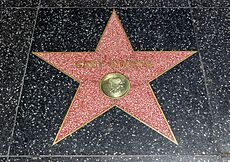
Gary Cooper's career lasted 36 years, from 1925 to 1961. He starred in 84 feature films. He was a huge movie star from the end of the silent film era through the Golden Age of Hollywood. His natural acting appealed to everyone. He played roles in many types of movies, including Westerns, war films, dramas, and comedies.
He was one of the top-10 film personalities for 23 years in a row, from 1936 to 1958. He was also one of the top money-making stars for 18 years, topping the list in 1953.
In more than half of his films, Cooper played Westerners, soldiers, or explorers. In others, he played doctors, professors, artists, and even a baseball player. His heroic image changed over time:
- In early films, he was a young, innocent hero (The Virginian).
- Later, he played more cautious heroes in adventure films (A Farewell to Arms).
- During his peak (1936-1943), he played a new kind of hero: a champion of the common person willing to sacrifice for others (Mr. Deeds, Meet John Doe).
- In his later years, he played heroes who faced the world alone (High Noon).
- In his final films, his characters rejected violence and sought to regain their honor (Friendly Persuasion, Man of the West).
The image he created throughout his career was of the ideal American hero: a tall, handsome, honest man who preferred action over talking.
On February 6, 1960, Cooper received a star on the Hollywood Walk of Fame. He also has a star outside the Ellen Theater in Bozeman, Montana.
In 1961, he received the French Ordre des Arts et des Lettres for his contributions to the arts. He also received a special award in Italy for his career.
In 1966, Cooper was added to the Hall of Great Western Performers. In 2015, he was inducted into the Utah Cowboy and Western Heritage Hall of Fame. The American Film Institute (AFI) ranked Cooper 11th on its list of the 25 greatest male stars of classic Hollywood. Three of his characters (Will Kane, Lou Gehrig, and Sergeant York) are on AFI's list of the 100 greatest heroes. His line as Lou Gehrig, "Today, I consider myself the luckiest man on the face of the earth," is ranked as the 38th greatest movie quote of all time.
More than 60 years after his death, Cooper's image as the ideal American hero lives on in his films. Actor Charlton Heston said, "He projected the kind of man Americans would like to be, probably more than any actor that's ever lived."
Gary Cooper is still referenced in popular culture. In the TV series Justified, the main character, U.S. Marshal Raylan Givens, looks up to Gary Cooper. When asked how his dangerous plan could work, he replies: "Why not? Worked for Gary Cooper."
In The Sopranos TV series, the main character, Tony Soprano, asks, "What ever happened to Gary Cooper? The strong, silent type..."
The 1930s hit song "Puttin' On the Ritz" mentions Cooper in the line, "Tryin' hard to look like Gary Cooper, Super duper!" This line was kept in a new version of the song released in 1983.
In J. D. Salinger's book The Catcher in the Rye, the character Holden Caulfield pretends to spot Gary Cooper to distract a woman.
Awards and Nominations
| Year | Award | Category | Film | Result | Ref |
|---|---|---|---|---|---|
| 1937 | Academy Award | Best Actor | Mr. Deeds Goes to Town | Nominated | |
| 1937 | New York Film Critics Circle Award | Best Actor | Nominated | ||
| 1941 | Sergeant York | Won | |||
| 1942 | Academy Award | Best Actor | Won | ||
| 1943 | The Pride of the Yankees | Nominated | |||
| 1944 | For Whom the Bell Tolls | Nominated | |||
| 1945 | New York Film Critics Circle Award | Best Actor | Along Came Jones | Nominated | |
| 1952 | Photoplay Award | Most Popular Male Star | High Noon | Won | |
| 1953 | Academy Award | Best Actor | Won | ||
| 1953 | Golden Globe Award | Best Actor | Won | ||
| 1953 | New York Film Critics Circle Award | Best Actor | Nominated | ||
| 1957 | Golden Globe Award | Best Actor | Friendly Persuasion | Nominated | |
| 1957 | New York Film Critics Circle Award | Best Actor | Nominated | ||
| 1959 | Laurel Award | Top Action Performance | The Hanging Tree | Won | |
| 1960 | They Came to Cordura | Won | |||
| 1961 | Academy Award | Academy Honorary Award | Won |
Filmography
Here is a list of feature films where Gary Cooper played a main role:
- The Winning of Barbara Worth (1926)
- Children of Divorce (1927)
- Arizona Bound (1927)
- Wings (1927)
- Nevada (1927)
- It (1927)
- The Last Outlaw (1927)
- Beau Sabreur (1928)
- The Legion of the Condemned (1928)
- Doomsday (1928)
- Half a Bride (1928)
- Lilac Time (1928)
- The First Kiss (1928)
- The Shopworn Angel (1928)
- Wolf Song (1929)
- Betrayal (1929)
- The Virginian (1929)
- Only the Brave (1930)
- The Texan (1930)
- Seven Days' Leave (1930)
- A Man from Wyoming (1930)
- The Spoilers (1930)
- Morocco (1930)
- Fighting Caravans (1931)
- City Streets (1931)
- I Take This Woman (1931)
- His Woman (1931)
- Devil and the Deep (1932)
- If I Had a Million (1932)
- A Farewell to Arms (1932)
- Today We Live (1933)
- One Sunday Afternoon (1933)
- Design for Living (1933)
- Alice in Wonderland (1933)
- Operator 13 (1934)
- Now and Forever (1934)
- The Lives of a Bengal Lancer (1935)
- The Wedding Night (1935)
- Peter Ibbetson (1935)
- Desire (1936)
- Mr. Deeds Goes to Town (1936)
- The General Died at Dawn (1936)
- The Plainsman (1936)
- Souls at Sea (1937)
- The Adventures of Marco Polo (1938)
- Bluebeard's Eighth Wife (1938)
- The Cowboy and the Lady (1938)
- Beau Geste (1939)
- The Real Glory (1939)
- The Westerner (1940)
- North West Mounted Police (1940)
- Meet John Doe (1941)
- Sergeant York (1941)
- Ball of Fire (1941)
- The Pride of the Yankees (1942)
- For Whom the Bell Tolls (1943)
- The Story of Dr. Wassell (1944)
- Casanova Brown (1944)
- Along Came Jones (1945)
- Saratoga Trunk (1945)
- Cloak and Dagger (1946)
- Unconquered (1947)
- Good Sam (1948)
- The Fountainhead (1949)
- Task Force (1949)
- Bright Leaf (1950)
- Dallas (1950)
- You're in the Navy Now (1951)
- It's a Big Country (1951)
- Distant Drums (1951)
- High Noon (1952)
- Springfield Rifle (1952)
- Return to Paradise (1953)
- Blowing Wild (1953)
- Garden of Evil (1954)
- Vera Cruz (1954)
- The Court-Martial of Billy Mitchell (1955)
- Friendly Persuasion (1956)
- Love in the Afternoon (1957)
- Ten North Frederick (1958)
- Man of the West (1958)
- The Hanging Tree (1959)
- They Came to Cordura (1959)
- The Wreck of the Mary Deare (1959)
- The Naked Edge (1961)
Radio Appearances
| Date | Program | Episode/source |
|---|---|---|
| April 7, 1935 | Lux Radio Theatre | The Prince Chap |
| February 1, 1937 | Lux Radio Theatre | Mr. Deeds Goes To Town |
| May 2, 1938 | Lux Radio Theatre | The Prisoner Of Shark Island |
| September 23, 1940 | Lux Radio Theatre | The Westerner |
| September 28, 1941 | Screen Guild Theater | Meet John Doe |
| April 20, 1942 | Lux Radio Theatre | North West Mounted Police |
| October 4, 1943 | Lux Radio Theatre | The Pride Of The Yankees |
| October 23, 1944 | Lux Radio Theatre | The Story Of Dr. Wassell |
| December 11, 1944 | Lux Radio Theatre | Casanova Brown |
| February 12, 1945 | Lux Radio Theatre | For Whom The Bell Tolls |
Images for kids
See also
 In Spanish: Gary Cooper para niños
In Spanish: Gary Cooper para niños


